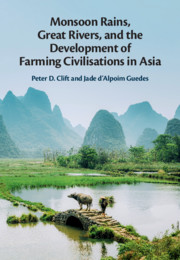Book contents
- Monsoon Rains, Great Rivers, and the Development of Farming Civilizations in Asia
- Monsoon Rains, Great Rivers, and the Development of Farming Civilizations in Asia
- Copyright page
- Contents
- Acknowledgments
- 1 Introduction
- 2 Temporal Variations in the Asian Monsoon
- 3 Monsoon and Societies in Southwest Asia
- 4 Origins of a Uniquely Adaptive Farming System:
- 5 Dryland Farming in the Northern Monsoon Frontier
- 6 Recent Changes in Monsoon Climate
- 7 Future Monsoon Predictions
- References
- Index
2 - Temporal Variations in the Asian Monsoon
Published online by Cambridge University Press: 17 December 2020
- Monsoon Rains, Great Rivers, and the Development of Farming Civilizations in Asia
- Monsoon Rains, Great Rivers, and the Development of Farming Civilizations in Asia
- Copyright page
- Contents
- Acknowledgments
- 1 Introduction
- 2 Temporal Variations in the Asian Monsoon
- 3 Monsoon and Societies in Southwest Asia
- 4 Origins of a Uniquely Adaptive Farming System:
- 5 Dryland Farming in the Northern Monsoon Frontier
- 6 Recent Changes in Monsoon Climate
- 7 Future Monsoon Predictions
- References
- Index
Summary
The Asian summer monsoon is strongly heterogeneous across the continent, with maximum rainfall around the Bay of Bengal, contrasting with the strongest winds in the Arabian Sea. Its intensity reflects the temperature difference between the ocean and continent, which has been accentuated by the rise of high topography following the collision of India and Asia. The monsoon is also sensitive to orbital variability and oceanic phenomena, such as El Niño, which causes weak rainfall in South Asia. The South and East Asian monsoons show moderate differences on millennial timescales as reconstructed from a variety of terrestrial and marine proxies. These point to the Early Holocene as being a time of strong rainfall with a decline after around 4000–5000 years ago. High-resolution reconstructions are possible from tree rings, which show important differences between East and South Asia. A seventeenth-century drought in North China was not mirrored in South and Southeast Asia, while during the Strange Parallels Drought (1756–1768) the reverse was the case. Historical records in China indicate that the north of the country has experienced more droughts than the South, especially during the Little Ice Age.
- Type
- Chapter
- Information
- Publisher: Cambridge University PressPrint publication year: 2021

